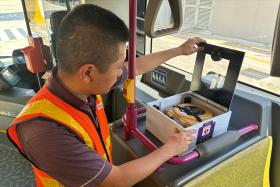Buses with green roofs hit the roads
Study to see if temperature in vehicles can be lowered, saving fuel
Singapore's first public buses with plants installed on their roofs - touted as the first in Asia - hit the road yesterday.
The Garden on the Move initiative by urban greenery specialist GWS Living Art was launched at Lakeside Garden.
Among the buses with the installed plants is a shuttle service that travelled in the Lakeside area. The special service ferried visitors to the Singapore Garden Festival Horticulture Show, which ended yesterday, to and from Chinese Garden MRT station and Lakeside Garden.
The initiative is part of a three-month study to see whether the temperature inside the buses can be lowered and potentially save on fuel.
The study will also involve another nine SBS Transit buses, some of which also started plying yesterday, including services 139, 145, 13, 39 and 45.
The buses are outfitted with a locally developed soil-less system called Gaiamat.
The initiative is funded by the Temasek Foundation and supported by the National Parks Board, Moove Media and the Singapore Green Building Council.
Dr Terrence Tan from the National University of Singapore (NUS), who is advising the study, said: "What is special in this case is that this green roof is on a bus.
"From our studies, we know the temperature reduction can be up to 20 deg C to 30 deg C on a hot day (for a building with a green roof), so we want to see if the same holds true for vehicles."
The plants chosen are hardy ones adapted to the local climate and are resistant to windy and dry conditions. They do not need to be watered frequently and will be checked once a week.
The plants are secured using a proprietary system called Gaiamat, a lightweight mat of rockwool material used for skyrise greenery that is easier to install and maintain.
GWS Living Art founder Zac Toh said Gaiamat can be put on buses because it is thin, with a weight of 25kg to 40kg per sq m.
With Gaiamat, maintenance for greenery on buildings is done two or three times a year.
Dr Tan, a research fellow from the NUS School of Design and Environment, said thermal sensors will be placed on the buses' rooftop under the plants and on the underside of the rooftop.
"To combat the urban heat island effect, we need to reduce temperature outdoors. By having greenery on surfaces such as on vehicles, it plays a part."
Get The New Paper on your phone with the free TNP app. Download from the Apple App Store or Google Play Store now


